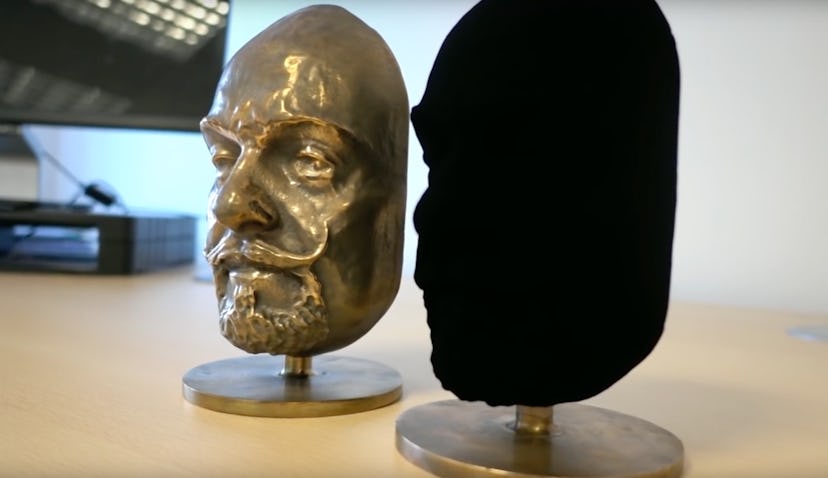The Worlds “Blackest Black” and the Hilarious Artist Feud Behind It
Anish Kapoor and Stuart Semple are at war over the world’s “blackest black,” but scientists might have the final say.

Bitter feuds bring nothing but darkness into the world. In the case of art, that might actually be a good thing. British artists Anish Kapoor and Stuart Semple are currently engaged in a public feud of the world’s “blackest back,” pigments so dark that they can actually render 3D objects visually flat at first glance. The back-and-forth seems to be inspiring some scientific breakthroughs.
The whole thing started over a a substance called Vantablack. Developed first at the United Kingdom’s National Physical Laboratory and manufactured by Surrey NanoSystems , the substance isn’t so much a color as it something of a blackhole. It absorbs 99.965 percent of visible light and literally traps it until it dissipates into heat. In fact, it’s not even technically a pigment. It’s a lab grown series of nano-tubes. The substance has lots of practical scientific applications, like keeping light out of telescopes for example. Though, someone realized it might have artistic purposes as well, and a slightly altered version was developed (just ever so less “black” and known as Vantablack S-VIS).
The color was then licensed exclusively for artistic purposes to the studios of Anish Kapoor. Meaning that effectively he was the only artist in the entire world who could use it. It’s slightly ironic considering some of Kapoor’s most famed work is with reflective materials (indeed they’re prime art selfie destinations).
Predictably, other artists were upset, and discomforted over the idea that patents and exclusive licenses could effectively control who gets to exercise creativity. Though, Vantablack’s manufacturer has pointed out that the materials artistic uses are limited, it needs to be applied under specific conditions with experts on hand, and that it’s subject to UK Export Control laws. In other words, it’s not as easy as merely bottling it and selling it at the craft store.
For what its worth, Kapoor own use of the material has been limited, and he told The Guardian that he’s having problems in both figuring out how to use it and getting his hands on enough of the stuff. It can only be manufactured in 2 cm squares at a time.
Still, other in the art world found creative ways to protest. Artist and curator Stuart Semple was chief amongst them.
As a way of sticking it to Kapoor, he developed a line of pigments including the world’s “pinkest pink” and “glitteriest glitter” and said they were available for any artist in the entire world to use… except Kapoor.
“By adding this product to your cart you confirm that you are not Anish Kapoor, you are in no way affiliated to Anish Kapoor, you are not purchasing this item on behalf of Anish Kapoor or an associate of Anish Kapoor. To the best of your knowledge, information and belief this paint will not make it’s [sic] way into the hands of Anish Kapoor,” reads the purchasing term for each color.
Though, Kapoor did end up getting his hands on the pink, and conveyed the acquisition to Semple on Instagram in as cheeky of way as possible.
Of course, Semple’s colors were surely bright. He claims they were formulated to hold more pigment than typical artistic materials, but they weren’t the technical marvels that Vantablack is. Pink can be very pink, but it can’t trap light after all.
Well, as it turned out Semple did actually team up with scientists to create a black that may not be the “blackest black” but is still pretty damn black as far as practical art supplies are concerned. He calls it “black 2.0” and it does create the neat visual trick of rendering objects coated in it flat.
Those unicorns might look like paper cutouts glued on the wall at first, but they’re actually 3-d sculptures.
Oh, and Semple’s “black 2.0” smells of black cherries, a shot at the fact that Vantablack supposedly has a horrible chemical oder about it.
“This is not the blackest black in the world,” reads the product description. “It is however a better black than the blackest black in the world as it is actually usable by artists.”
“*except for Anish Kapoor.”
Semple claims he worked with color chemists to concoct the pigment, and notably it’s much easier to use than Vantablack. It can be applied like any paint, and is producible in quantities of more than 2 cm squares at a time.
Yet, it may be scientists that get the last laugh.
Surrey NanoSystems recently announced that they created another very black-black called VBx1. Unlike the fragile Vantablack, it is “a solid coating that is far more tolerant.”
Indeed, the preview video gives you an idea already of its possible artistic applications.
However, VBx1 is still in development, and as Kapoor’s exclusivity only extends to the use Vantablack S-VIS, it’s unclear at the moment whether or not more artists may be eventually be able to get to use the new product.
Watch: No Man’s Land: Just Nina Agdal and All-Female Art: